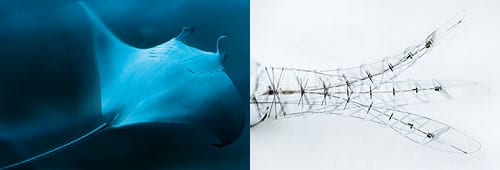A surprising biomechanical effect, discovered in morphological studies of fish fins, forms the basis for various biomimetic developments

Many biomimetic developments are associated with different effects. We have previously mentioned The lotus effect and you The pine cone effect. This month we will expand on another effect: the fish fin effect. ( Fin Ray Effect).
There are fish with bony fins, which are made of skin supported by bones or spines. These fins can have several bony spines, which are usually soft and flexible, sometimes they are separate and sometimes they are connected to each other. When lateral pressure is applied to the tail of the fin, the tip of the fin does not bend in the direction of the force as expected, but moves in the opposite direction. This unexpected displacement, opposite to the direction of the applied force, is called the fish fin effect. (Fin Ray Effect). This effect reduces the water's resistance to movement, allowing the fish to maximize the power of the fin movements in the water.
The fish fin effect can be explained as follows: two struts connected together at one end (similar to the spines of the fin) form a sharp triangle. Between them are additional supports in a ladder structure, which create a clear angle and keep the longitudinal supports separate from each other. When one of the two longitudinal supports in the fin structure extends through the triangular opening, the structure bends to the side and creates an arched structure, depending on the number of connecting supports, their arrangement and degree of rigidity.
The effect is registered as a patent and applied in a series of products. A structure based on this effect makes it possible to handle fragile objects such as glass containers in a way adapted to the shape, and allows them to be lifted and moved without creating pressure points.
A possible application of this effect is in the design of pressure-responsive car seats. When driving on a road curve, the driver sitting on a chair will be pressed against the side of the seat. If the fish fin effect is applied to the seat, the longitudinal supports will maintain the position of the driver in the seat without exerting pressure on him.
Another example of the application of the effect is the development of the company Festo - a robotic arm based on the structure of the elephant's trunk. The collector connected to the arm, known as Finray, is based on a thin and flexible material that folds towards the source of pressure, and allows for the collection of delicate and fragile items such as Easter eggs.

5 תגובות
The explanation is not very clear. "Can it be explained as follows"? You specified a structure but did not explain it
A video demonstrating the effect:
http://vimeo.com/22887842
Some genius now that he has issued a patent for the effect will be able to claim half of the fish.
Somewhat reminiscent of the butterfly effect and Georg Nielsen who patented it and is now a prison attorney.
To maximize means to reach the maximum. A possible translation is Merab from the adjective Meirbi. A root of 3 letters is obtained from R.B. probably in the Pi'el building
"Allows the fish to maximize"...
How do you say "maximum" in Hebrew?
So what is "maximize"?